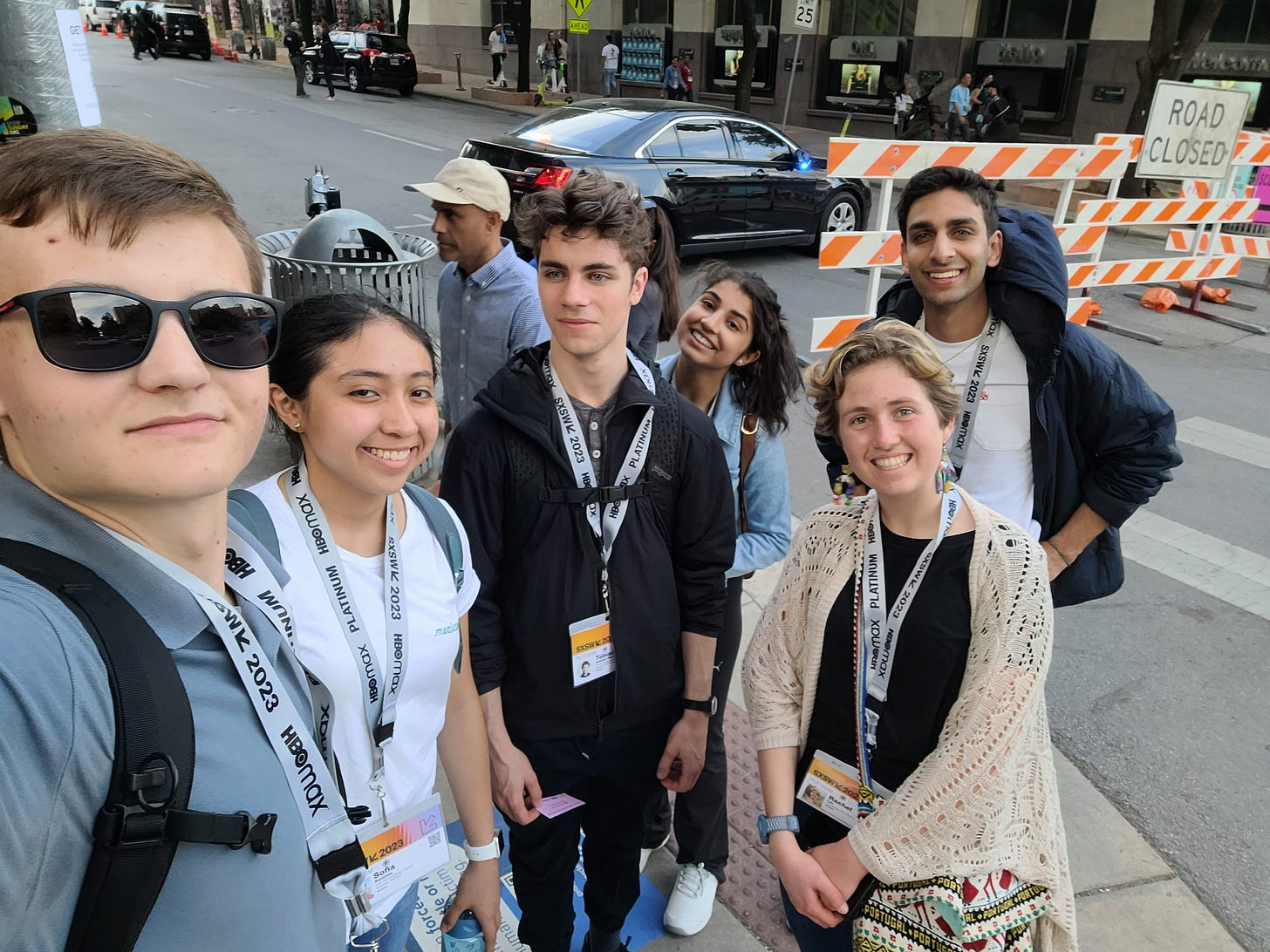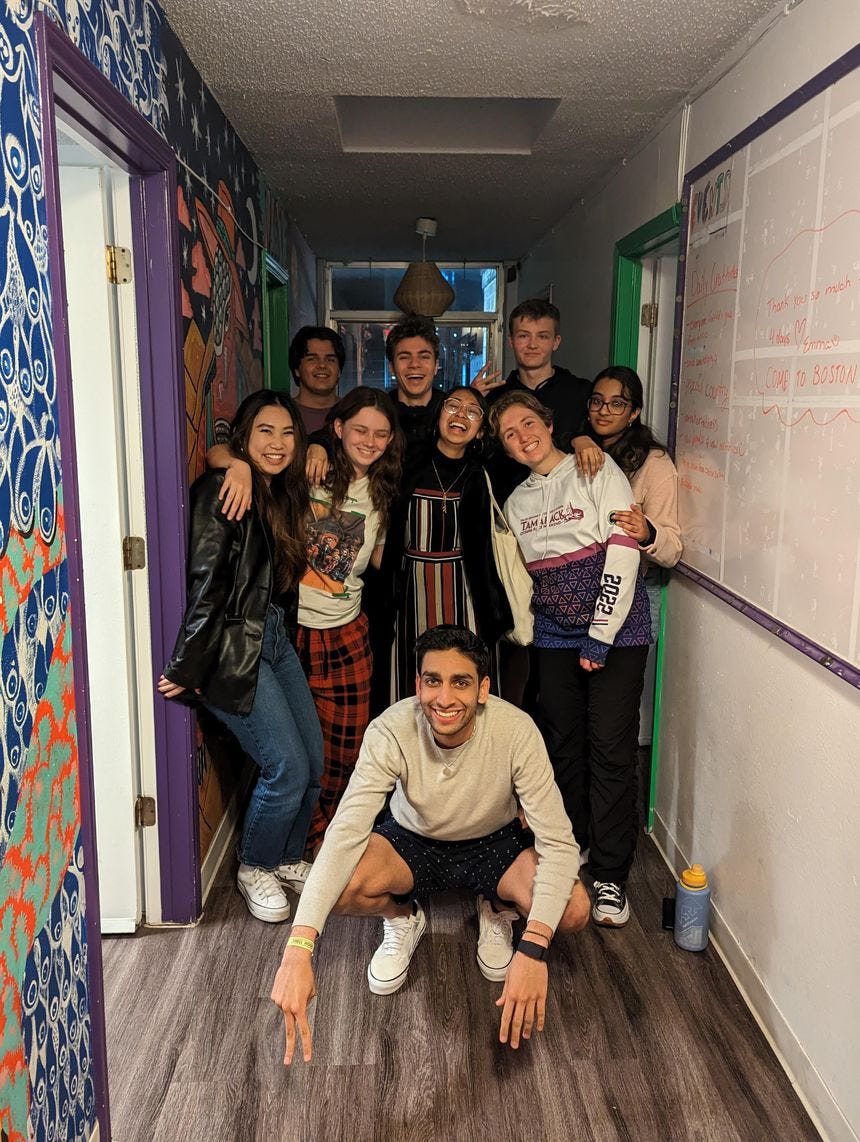Finding Your Tribe: February and March 2023
A collection of learnings, experiences and reflections that have shaped me
Hey everyone! Welcome (back) to my monthly summary of learnings and experiences, culminated into one newsletter. This is my space to provide you, the reader, with the things that I’ve found valuable, in the hopes that they’ll help you, too.
My name is Alex, a now 17 y/o builder working in the AgTech space looking for ways to improve outcomes for farmers. I’m currently working with computer vision and drone technology to explore ways that farmers can more efficiently diagnose and treat diseases in their fields.
I tried something new this month: a newsletter in video format.
It was definitely a different experience to what I’m used to doing, but I enjoyed it because I found that there was more connection between you, the viewer, and me. It flowed and was unstructured, which has its own positives and detriments. I’m considering making this a permanent feature, but the audience is still out on whether it’s valuable.
So, what did I get up to over the past two months?
That’s a loaded question to answer, but I’ll do my best to answer it, sharing my learnings along the way.
Problems Incentivized by Economics
I’ve spent most of these two months working on a consulting challenge alongside CAE. It’s one of the companies you don’t realize exist, simply because they don’t build consumer facing products, but when you peel back the curtain you understand just how large a player they are. If you were to ask a pilot where they’d spent most of their time during their training, they’d respond that they were in a CAE simulator. Likewise, any defense contractor has likely worked with CAE on a project.
What I like about the company is that they go out and build the hard tech that’s tailor-fit to customer’s needs — a mindset that I’m developing as I talk to customers in field I’m addressing. With flight simulators, they build a cockpit to the exact specs of the real thing, all the way down to the buttons replicating the tactility of what a pilot would experience on a real jet. They’ve created a 1:1 digital world in their simulators, and they’ve taken their replication even further with the collection of thousands of hours of flight data for individual aircraft and incorporated it, mirroring the exact reaction to crosswind and the additional lift of flaps, among others. It’s the attention to detail that sets them apart from other players in the industry, and what’s allowed them to gain a 95% market share in the aircraft simulator space.

We were tasked with finding the next market opportunity for CAE to capitalize on as they expanded the business. Ambiguity is a potent poison. So many aspects of my life up to this point have inherently involved some sort of structure, a guiding force that takes people along with it so they don’t wash up on shore. School, sports, extra-curriculars — everything comes with a rigidity and a clearly outlined set of rules. Do X, repeat Y times, and achieve outcome Z.
You’ve given structure to a child since the day it was born, but what happens when you ask them to do something they’ve never seen before, let alone done before? According to Darwin, they evolve. It’s survival of the fittest, and they want to survive. It’s in that adaptation that the greatest growth comes from. You may flounder around the first five, ten, fifteen times, but by your hundredth attempt, you know how to approach the problem, no matter what it is.
In the chaos of disorder, you have to make make it make sense. All of the smartest people I’ve ever met or listened to have an uncanny ability to be dropped into an environment of which they have no understanding, and quickly create structure that informs a decision-making process. It turns into a game of quickly gathering data, applying tried and true mental models, and making a decision with the knowledge that you may not be right.
People spend way too much time deliberating whether or not they’re making the right choice, too. Ultimately, there’s no answer to that question, because you can’t see into the future. Moreover, the more time you spend agonizing over a decision, the more time and capital runway you burn. Over the course of this challenge, I realized that you’re never going as much data as you want or need. When you get access to a new insight or datapoint, the default mode of the human brain is wanting more. I can see why that might be an important trait for hunter-gatherers to develop as they learned about animal migration patterns, but in today’s environment, it’s more conducive to analysis paralysis.
The real skill development is doing the most with what you have. Whether it be access to data or capital, nothing will ever be enough. Being able to take decisive action in the face of adversity is the defining skill for the 21st century. Forget about the predictive modelling and ML forecasting — at the end of the day, you’re the one that is going to make the decision. You’re going to get differing opinions as to what you should do all of the time, and you’re going to hesitate. But my biggest takeaway is to do the thing. Empirically, it’s a case of achieving something against not doing anything at all, and if you don’t make the right choice: iterate.
I was listening to Tim Ferriss’ podcast with David Deutsch and Naval Ravikant the other day, and one of the things David said really stuck out to me:
‘The simple secret to coming up with lots of good ideas is to come up with lots of bad ones.’
Even the world-class thinkers don’t always get everything right, but that’s the inherent beauty of rational thought. It’s a thirst for being right that drives you forward.
Another thing that I’ve quickly grown to understand is that absolutely everything is driven by economics — and that I should start paying more attention in my econ class. You can build a strong product that has the potential to change the world, but if the economics (the affordability of the product relative to its output) is not there, it simply will not catch on.
It’s all too easy for founders to put a TAM number on their slides and call it a day, but if you’re not creating spreadsheets and doing detailed analysis on base cases, you’re doing it wrong. As I said earlier, you can’t predict the future, but it’s better to have a picture of what it may look like.
One thing that I liked about the way CAE operates is that they’re focused on building lasting relationships, whether it be with clients or governments. Ultimately, there has to be some end-user of your product, and if you’re not aligned with them on what they want out of your offering, there’s a trivial chance at success. If there’s one thing that you’re going to do as you set out in search of a solution, it’s talking to the end user early and often.
I think this is largely where we failed in our thinking. We made too many assumptions on what people wanted out of our product and what they would be willing to pay for it. The idea itself was interesting as a business proposition, but the details were not fleshed out thoroughly enough to implement.
Nonetheless, this foray into ambiguity and a lack of direction was a valuable learning experience. In my conversations with established founders, I found that dealing with the undefined nature of the next step was, and to a certain extent still is, one of the biggest blockers when building a company. In my opinion, it’s better to deal with it early and get comfortable with the fact that life isn’t a math test anymore, where you can reason out each of the questions.
With the increased investment opportunity in the ‘Time of Plenty’ over 2020-2022, the life of a founder became glamourized. Too many people peer into the doorway and think — ‘I could do that!’ What we’re increasingly going to see over the next couple of years is distinct return to reality, marked by thoughtful consideration, careful business planning, and an increased sense of urgency to get things done. I’m excited to see what the next generation of founders breathes into the world.
What it Means to be a Leader
As I worked through this consulting challenge, I began to reflect on my previous experiences working with teams and what led me to success. I read over one of my older articles from an experience working with IKEA on their store of 2030, and I still resonate with all of the points that I mentioned there. Without reading it, the simplest way I can sum it up is:
Attitude is Altitude.
Your outlook on what you’re working on will dictate what your output is. If you hate the work you’re doing, you shouldn’t be surprised when the quality of your work is subpar. There are steps that you can take to limit your hatred towards your work, and conversely, ways to increase your motivation and excitement to work on solving it.
But every new experience brings about new learnings, and I’d like to tack on to that article here.
When your working in a team, you have to understand that the PM is the life-blood of everything that happens. As my friend Kevin put it:
When you’re a leader, you have to accept responsibility for everything that happens within your group, whether or not your at fault. If it fails, you failed. If it succeeds, your team succeeded.
When the going gets tough, you have to get tough. There will be times that you feel you won’t be able to succeed, and you will feel de-motivated from pursuing the problem. Your team will feel the exact same way. But you, as a leader, have to recognize that the job is not finished. There is still work to do, and you’re the one who’s ultimately responsible for getting it done.
You have to remember that your team is looking at you for guidance, so you must set the example for what you want your team to look like. If you’re flailing around, looking for a life buoy, can you seriously expect your team to be acting any differently? That’s exactly the reason why the best generals were so respected by their troops — they didn’t sit around behind the front drinking champagne, but rather pushed with them into the field of battle. General George Patton, a renowned leader known for being extremely efficient with his men, noted that:
No good decision was ever made in a swivel chair.
When your team doesn’t want to put in the late hours and weekends to make things work, it’s on you. As you show your dedication to your craft, people want to join in, because they can see firsthand just how dedicated you are to making something great. And even if they don’t, you know you put in the work. If it really matters that much to you, you’ll make it happen.
Another important point to note is the essence of effective communication, which I believe has two critical factors: when and how you speak with your team.
When is the easier question to answer. I’ve found that syncing every day has been the most effective tool, keeping all of the other team members updated on what we achieved throughout the day, and what we were planning for the next. It’s a forcing function to get things done each day, even if they were small pieces of progress. The compounding effects of a daily ritual create end results that are ten times what they would have been without them.
Length of meetings is also an important factor. I usually find that 20 minutes works best — long enough to share updates for the day and planning for the next, while leaving with enough energy and focus that any longer meeting would have quickly drained out of you. Of course, this isn’t a strict ordination of meeting duration, simply a good measure for how most meetings should go.
Find times that work across a multitude of days. Meetings aren’t as effective when people have to miss them for other responsibilities, and the action items quickly pile over from one meeting to the next. If each of your team members are generally free at 7 each night, that’s the best time to meet. It gives you enough time to get work done before the sync, while leaving enough time after to work on new action items or to pivot if necessary.
How is a matter of perfecting the skill of communication. Funnily enough, this made me think of a quote I read from Shakespeare, as we’re studying Hamlet in English class:
Brevity is the soul of wit.
Here’s another one that I like, this time from physicist Blaise Pascal:
If I had more time, I would have written a shorter letter.
Simply put, say what you need to say, without saying any more. It’s much too enticing to get caught rambling, but the accelerated meeting times are a forcing function to improve your communication.
Before a meeting, make clear goals that you want to attain by the end of it, and take some time to think about what you’re going to say while on call, to make the most use out of your and your teammates time. Before you leave, set clear action items that are time-bound: end of day, before the next sync, end of week, etc.
Perhaps even more important are the updates you’re sending between meeting times, letting everyone else know where progress is at or simply sharing your point of view on an issue you’re facing. I’ve found written messages to be useful, but at some points, a verbal, communicated message is really needed to get your point across. Something as simple as sending a Loom video pouring over research you’ve done or a voice message update can have a significant impact on alignment before the next meeting.
As a PM, it’s your responsibility to keep everyone motivated to keep going on a project, whether or not you are motivated. Pay close attention to the way that you express yourself, as this shapes the overall mood in the team. One of my favorite strategies was to send an hourly text with the thing I was working on, and the successes that I’d had with it. Doing this, everybody felt like they needed to play their part, and saw that success was a function of the work they put in.
In the end, we ended up presenting to the VP of Innovation and his team, and received lots of pointed feedback on where we were vindicated in our thinking and where we still needed to improve, especially concerning technical depth. It was one of those situations that you didn’t know what you didn’t know unless you spent years in industry, and given our timeline of about a month, I would say we did quite well. Another project, another experience.
Becoming the Best: Thoughts from SXSW
I had the opportunity to head down to Austin for SXSW this year, escaping the brutal Torontonian winter. I was also lucky enough to present on my AgTech project, and how I’m thinking about leveraging drones for crop disease treatment, which was an awesome experience in its own right.
But what I enjoyed the most was being surrounded by some of the most ambitious young people I have ever met. I’ve been talking to these friends online for years, and finally having the opportunity to meet them in person has been awesome. It’s one of those fulfilling moments where you know, in the moment, that this will be a memory you retain for the rest of your life.
Being in Austin really reinforced the importance of environment to who you become as a person. Constantly being intellectually engaged and challenged, while also having a good laugh right after, is the kind of environment that is most conducive to growth. Seeing other people pursuing their dreams and achieving greatness pushes you along the same path.
I’ve been talking to my friends about the idea of achieving greatness, and I really liked an idea Tobias posed to me:
There are no sacrifices when you’re doing something you love, because there’s nothing else you’d rather be doing.
If you ask an athlete the ‘sacrifices’ they’ve made to pursue greatness, they’d likely answer with their social lives, relationships, whatever. They’re simply saying these things to fulfill the people watching at home, making them think: ‘Hey, I may not be as great as they are, but at least I have X, Y and Z. I wouldn’t want to be in his situation.’
But the truth is, they didn’t really care about those things in the first place. They were so dedicated to their sport, that there was nothing else in the world that could draw them away from it, so it wasn’t a sacrifice that they made, but rather an optimization of their time for what they wanted to achieve in life.
People are scared. They write off their efforts as trying their best — sure, this works to some degree, but you at some point you have to push yourself beyond what you know how to do. It may seem scary, but at some point you’re going to have to push for the ultimate outcome — being the best.
Doing the hard things is never easy. Doing them every single day of your life is never easy. But if something is not hard, there’s no point in doing it. If you’re not pushing yourself to get better in every single moment of your life, you’re choosing to get worse.
Building the community where doing the hard things is valued above all else, where there is collective suffering in the pursuit of a higher goal , where everybody believes in each other’s potential is why the mafias — PayPal or otherwise — exist. Communities form to create a higher ideal beyond their component individuals, where the individuals are elevated to a state that is far beyond what they could have achieved outside of that community.
Keeping the mindset of doing the hard things alive when leaving SXSW was difficult — you return to your routine life, waking up in the morning, going to school, coming home tired, and juggling responsibilities. That’s where your community comes in, allowing you to keep pushing yourself despite the external circumstances you’re subject to. One thing I will note: community building online doesn’t work to the same level that in-person building does.
When you live with someone, you see all of the aspects of their character, not just the façade they put on for the couple of hours online. You realize that everyone is human, but you appreciate them for the entirety of their being, instead of some idealized demi-god you picture them to be. It’s the common humanity that pushes you together and accelerates like a rocket towards success. The bonds you’re able to build with somebody in short time of living together far outweigh any online connection you could form. Everyone talks about the Internet as being the great connection of the world, because it is. But there’s some form of human contact that it will never be able to replace.
I could expand on this point for hours, but I’ll leave this point, and this newsletter, off with one of the quotes sticky-noted to my wall:
We few, we happy few, we band of brothers, For he today that sheds his blood with me, shall be my brother.
William Shakespeare









